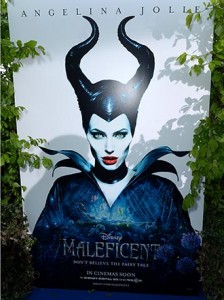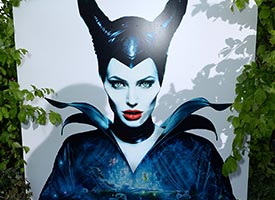(Rated PG; directed by Robert Stromberg; stars Angelina Jolie, Sharlto Copley, Elle Fanning; run time: 97 minutes.)
‘Sleeping Beauty’ remake casts witch as villain-hero
By Ted Giese
In “Maleficent,” the “imagineers” at Disney have worked to re-imagine “Sleeping Beauty” (1959), the cartoon based in part on two folktales: the older “The Sleeping Beauty in the Wood” by Charles Perrault and the newer, simpler “Brier Rose”by the Brothers Grimm.

The familiar fairy tale has become a family favorite for many. The likewise-loved Disney cartoon “Sleeping Beauty”gave the villain a name: Maleficent — a mash-up of Latin words meaning “harmful, with evil intent.” Think of the English words malefactor, maladjusted, malfeasance. Maleficent in Disney’s “Sleeping Beauty” is clearly intended to be evil, with animators giving her “devil horns.” Is this still the case in Disney’s new movie?
With this modern “live action” adaption of the folktale, the film begins by saying it will tell the viewer a story, and the viewer is to see how well he knows it. From the outset, it is plain that director Robert Stromberg is employed to retell the story in a way that recasts the characters, shifting the focus from the folktale’s general narrative onto the villain, thereby providing an origin story for the character Maleficent.
As in the Gregory Maguire novel Wicked: The Life and Times of the Wicked Witch of the West, where the wicked witch is made into a misunderstood hero, here Stromberg takes Maleficent (Angelina Jolie) away from pure villainy to godmotherhood.
Retaining the Perrault language of “christenings” and “godmothers” missing from the Brothers Grimm’s Brier Rose, the film “Maleficent” mixes in Christian terminology and ideas. Screenwriter Linda Woolverton, through the cinematic rehabilitation of the title character, brings in another Christian theme absent from the original fairy tales: forgiveness. Woolverton banks on the hope that, somewhere in the North American psyche, people still understand that evil needs to be overthrown by love and forgiveness, and that repentance plays a key part in this.
Overall, while the film provides moments of forgiveness between characters, it only flirts with repentance in the end. Maleficent is praised for both her villainous and heroic sides. The movie begins by saying the only thing that could bring two neighboring countries together would either be a great hero or a great villain. The movie ends saying that it wasn’t having one or the other that brought the two countries together; rather, it was having one person who embodied both these things that brought them together.
Lutheran viewers of “Maleficent” may begin to see something that starts to look like simul justus et peccator — a Latin phrase used by Luther meaning “at once a saint and a sinner.”On the one hand, Maleficent plots and carries out revenge on Aurora’s father, King Stefan (Sharlto Copley), by cursing Aurora (Elle Fanning). On the other hand, Maleficent shows love and acts as a godmother to the same girl she cursed.
There is a point in the film where Aurora stops calling Maleficent her fairy godmother and simply starts calling her godmother. This is one of the reasons that Maleficent is portrayed as both villain and hero, one who is simultaneously an evil sinner and justified. The question might then be asked, “How is she justified within the story? Is this classic justification from a biblical perspective or is it pop-American justification?”
Maleficent’s justification is not purely external in nature. It is not applied to her as the waters of baptism are applied in the Christian sacrament. Screenwriter Woolverton provides reasons and justification for Maleficent’s vengeance, but what’s missing for Christian viewers is sorrow over the character’s evil actions. Yes, there are moments of regret, and even one scene where Maleficent tries to take back her curse, but by the end of the film viewers are left with a sort of “all’s well that ends well” or an “ends justify the means” conclusion.
Maleficent is, therefore, in the narrative of the film, justified in her actions because of what was done to her — standard revenge-film stuff. Christian viewers may want to ask, “Are personal evil deeds permissible providing something evil is being avenged?” St. Paul writes, “Beloved, never avenge yourselves, but leave it to the wrath of God, for it is written, ‘Vengeance is mine, I will repay,’ says the Lord” (Rom. 12:19).
Where Disney’s cartoon “Sleeping Beauty” had its central focus on the unfolding drama of Princess Aurora’s misfortune and its reversal, the curse and the breaking of it take a back seat in “Maleficent.” The foreground drama owes a greater debt to English playwright William Congreve’s line, “Heaven has no rage like love to hatred turned, nor hell a fury like a woman scorned,” which is regularly paraphrased as “Hell hath no fury like a woman scorned.”
In Disney’s “Sleeping Beauty,” Maleficent is scorned because she isn’t invited to the christening. This awkward situation is compounded in the new film because, as a young fairy, Maleficent had fallen in love with the future king Stefan, a young orphaned thief, who stole her heart with “true love’s kiss.” Stefan betrays this love when he drugs her and steals something else from her, cutting off her fairy wings in exchange for his personal self-advancement — the chance to become king.
Viewers quickly see that Maleficent is not the only character being reinvented in the movie. King Stefan also has undergone a dramatic change. He, like Maleficent, is dragged from the background of the folktale into the foreground. But Woolverton’s spotlight on King Stefan is not as kind as her spotlight on Maleficent. Along with almost all the other male characters, he is shown to be untrustworthy and treacherous. The male characters in this movie are either greedy or cowardly and provide no strong male role models for children.
Which leads to the last and maybe the first question concerning this film: For whom is it made? Is it a children’s movie? Woolverton wrote the screenplays for Disney’s “The Lion King” (1994) and the more recent “Alice in Wonderland” (2010). “Maleficent” is more like the latter and is a little too dark for sensitive children, with its images of cruelty that aren’t addressed well. Fairy tales as a genre do regularly deal with cruel content, yet they also balance it by providing a strong moral compass.
Relativism and revisionism don’t often provide the same sort of strong moral compass generally expected from the classical fairy tale. Does this mean folktales are off limits for creative re-imaginings? No, but it’s more challenging to be creative with a story people already know and even love than it is to be creative with new material.
In the hands of a more accomplished director, “Maleficent” could have been a very interesting film, but the whole thing gets away on Stromberg. The film’s conclusion is not as satisfying as its opening; it starts out wide awake but slowly falls asleep, and no amount of passion or love from the creative team behind “Maleficent” can provide a kiss capable of waking it back up again.
Even with some very enchanting moments, this sleeping beauty has missed the mark and likewise missed its wake-up call.
The Rev. Ted Giese is associate pastor of Mount Olive Lutheran Church, Regina, Saskatchewan, Canada; a contributor to The Canadian Lutheran and Reporter; and movie reviewer for the “Issues, Etc.” radio program.
Posted June 6, 2014
